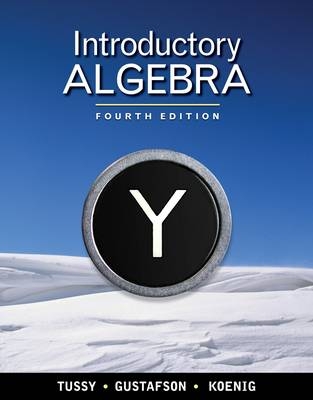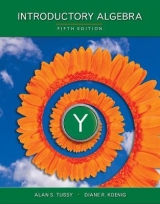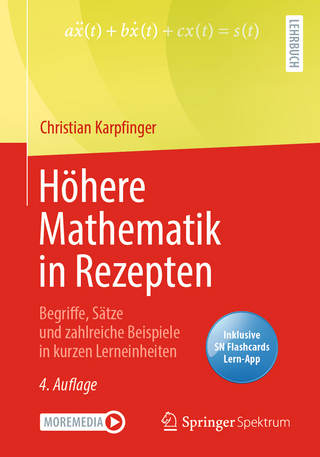
Introductory Algebra
Brooks/Cole (Verlag)
978-1-4390-4787-3 (ISBN)
- Titel erscheint in neuer Auflage
- Artikel merken
Offering a uniquely modern, balanced approach, Tussy/Gustafson/Koenig's INTRODUCTORY ALGEBRA, Fourth Edition, integrates the best of traditional drill and practice with the best elements of the reform movement. To many developmental math students, algebra is like a foreign language. They have difficulty translating the words, their meanings, and how they apply to problem solving. Emphasizing the "language of algebra," the text's fully integrated learning process is designed to expand students' reasoning abilities and teach them how to read, write, and think mathematically. It blends instructional approaches that include vocabulary, practice, and well-defined pedagogy with an emphasis on reasoning, modeling, communication, and technology skills.
R. David Gustafson is Professor Emeritus of Mathematics at Rock Valley College in Illinois and has also taught extensively at Rockford College and Beloit College. He is coauthor of several bestselling mathematics textbooks, including Gustafson/Frisk/Hughes' COLLEGE ALGEBRA, Gustafson/Karr/Massey's BEGINNING ALGEBRA, INTERMEDIATE ALGEBRA, BEGINNING AND INTERMEDIATE ALGEBRA, BEGINNING AND INTERMEDIATE ALGEBRA: A COMBINED APPROACH, and the Tussy/Gustafson and Tussy/Gustafson/Koenig Developmental Mathematics series. His numerous professional honors include Rock Valley Teacher of the Year and Rockford's Outstanding Educator of the Year. He has been very active in AMATYC as a Midwest vice president and has been president of IMACC, AMATYC's Illinois affiliate. He earned a Master of Arts from Rockford College in Illinois, as well as a Master of Science from Northern Illinois University. A nationally recognized educator and author, Diane Koenig actively shaped several textbooks, ancillaries and series. Since 1982 when she helped develop the Gustafson/Frisk series to her work on the Tussy/Koenig/Gustafson series, Diane’s writing continues to reflect the expertise she gains from working with students in her Mathematics courses. Throughout her work, she integrates research-based strategies in Mathematics education. She earned a Bachelor of Science degree in Secondary Math Education from Illinois State University in 1980, and began her career at Rock Valley College in 1981, when she became the Math Supervisor for a newly formed Personalized Learning Center. Earning her Master's Degree in Applied Mathematics from Northern Illinois University in 1984, Diane, enjoys the distinction of being the first woman to become a full-time faculty member in the Mathematics department for Rock Valley College. In addition to being awarded AMATYC's Excellence in Teaching Award in 2015, she was chosen as the Rock Valley College Faculty of the Year by her peers in 2005, and the next year she was awarded the NISOD Teaching Excellence Award and the Illinois Mathematics Association of Community Colleges Award for Teaching Excellence. In addition to her teaching, she is an active member of the Illinois Mathematics Association of Community Colleges (IMACC), serving on the board of directors, on a state-level task force rewriting the course outlines for the Developmental Mathematics courses, and as the Association's newsletter editor. Alan Tussy has taught all levels of developmental mathematics at Citrus College in Glendora, CA. He has written nine math books. An extraordinary author dedicated to his students' success, he is relentlessly meticulous and creative—a visionary who maintains a keen focus on the greatest challenges students face in Mathematics. Alan received his Bachelor of Science degree in Mathematics from University of Redlands and his Master of Science degree in Applied Mathematics from California State University, Los Angeles. He has taught across course and curriculum areas from prealgebra to differential equations. He is currently focusing on teaching courses related to Developmental Mathematics. Professor Tussy is a member of the American Mathematical Association of Two-Year Colleges (AMATYC).
1. AN INTRODUCTION TO ALGEBRA.
The Language of Algebra. Fractions. The Real Numbers. Adding Real Numbers; Properties of Addition. Subtracting Real Numbers. Multiplying and Dividing Real Numbers. Exponents and Order of Operations. Algebraic Expressions. Simplifying Algebraic Expressions Using Properties of Real Numbers. Chapter 1 Summary and Review. Chapter 1 Test.
2. EQUATIONS, INEQUALITIES, AND PROBLEM SOLVING.
Solving Equations Using Properties of Equality. More about Solving Equations. Applications of Percent. Formulas. Problem Solving. More about Problem Solving. Solving Inequalities. Chapter 2 Summary and Review. Chapter 2 Test. Chapters 1-2 Cumulative Review Exercises.
3. GRAPHS, LINEAR EQUATIONS, AND FUNCTIONS.
Graphing Using the Rectangular Coordinate System. Equations Containing Two Variables. Graphing Linear Equations. Rate of Change and the Slope of a Line. Slope-Intercept Form. Point-Slope Form; Writing Linear Equations. Graphing Linear Inequalities. Functions. Chapter 3 Summary and Review. Chapter 3 Test. Chapters 1-3 Cumulative Review Exercises.
4. SOLVING SYSTEMS OF EQUATIONS AND INEQUALITIES.
Solving Systems of Equations by Graphing. Solving Systems of Equations by Substitution. Solving Systems of Equations by Addition (Elimination). Problem Solving Using Systems of Equations. Solving Systems of Linear Inequalities. Chapter 4 Summary and Review. Chapter 4 Test. Chapters 1-4 Cumulative Review Exercises.
5. EXPONENTS AND POLYNOMIALS.
Natural-Number Exponents; Rules of Exponents. Zero and Negative Integer Exponents. Scientific Notation. Polynomials. Adding and Subtracting Polynomials. Multiplying Polynomials. Dividing Polynomials by Monomials. Dividing Polynomials by Polynomials. Chapter 5 Summary and Review. Chapter 5 Test. Chapters 1-5 Cumulative Review Exercises.
6. FACTORING AND QUADRATIC EQUATIONS.
The Greatest Common Factor; Factoring by Grouping. Factoring Trinomials of the Form x2 + bx = c. Factoring Trinomials of the Form ax2 + bx + c. Factoring Perfect-Square Trinomials and the Difference of Two Squares. Factoring the Sum and Difference of Two Cubes. A Factoring Strategy. Quadratic Equations. Applications of Quadratic Equations. Chapter 6 Summary and Review. Chapter 6 Test. Chapters 1-6 Cumulative Review Exercises.
7. RATIONAL EXPRESSIONS AND EQUATIONS.
Simplifying Rational Expressions. Multiplying and Dividing Rational Expressions. Adding and Subtracting with Like Denominators; Least Common Denominators. Adding and Subtracting with Unlike Denominators. Simplifying Complex Fractions. Solving Rational Equations. Problem Solving Using Rational Equations. Proportions and Similar Triangles. Variation. Chapter 7 Summary and Review. Chapter 7 Test. Chapters 1-7 Cumulative Review Exercises.
8. ROOTS AND RADICALS.
Square Roots. Higher-Order Roots; Radicands That Contain Variables. Simplifying Radical Expressions. Adding and Subtracting Radical Expressions. Multiplying and Dividing Radical Expressions. Solving Radical Equations; the Distance Formula. Rational Exponents. Chapter 8 Summary and Review. Chapter 8 Test. Chapters 1-8 Cumulative Review Exercises.
9. QUADRATIC EQUATIONS.
Solving Quadratic Equations: The Square Root Property. Solving Quadratic Equations: Completing the Square. Solving Quadratic Equations: The Quadratic Formula. Graphing Quadratic Functions. Complex Numbers. Chapter 9 Summary and Review. Chapter 9 Test. Chapter 9 Cumulative Review Exercises.
| Erscheint lt. Verlag | 1.1.2010 |
|---|---|
| Verlagsort | CA |
| Sprache | englisch |
| Maße | 216 x 276 mm |
| Gewicht | 1684 g |
| Themenwelt | Mathematik / Informatik ► Mathematik ► Algebra |
| ISBN-10 | 1-4390-4787-1 / 1439047871 |
| ISBN-13 | 978-1-4390-4787-3 / 9781439047873 |
| Zustand | Neuware |
| Informationen gemäß Produktsicherheitsverordnung (GPSR) | |
| Haben Sie eine Frage zum Produkt? |
aus dem Bereich



